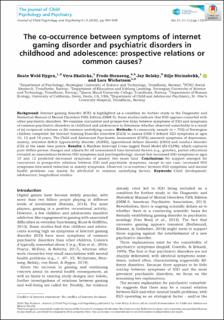| dc.contributor.author | Hygen, Beate Wold | |
| dc.contributor.author | Skalicka, Vera | |
| dc.contributor.author | Stenseng, Frode | |
| dc.contributor.author | Belsky, Jay | |
| dc.contributor.author | Steinsbekk, Silje | |
| dc.contributor.author | Wichstrøm, Lars | |
| dc.date.accessioned | 2021-04-22T08:08:49Z | |
| dc.date.available | 2021-04-22T08:08:49Z | |
| dc.date.created | 2020-07-22T10:50:34Z | |
| dc.date.issued | 2020 | |
| dc.identifier.citation | Journal of Child Psychology and Psychiatry. 2020, 61 (8), 890-898. | en_US |
| dc.identifier.issn | 0021-9630 | |
| dc.identifier.uri | https://hdl.handle.net/11250/2739006 | |
| dc.description.abstract | Background: Internet gaming disorder (IGD) is highlighted as a condition for further study in the Diagnostic and Statistical Manual of Mental Disorders Fifth Edition (DSM‐5). Some studies indicate that IGD appears comorbid with other psychiatric disorders. We examine concurrent and prospective links between symptoms of IGD and symptoms of common psychiatric disorders in childhood and adolescence to determine whether observed comorbidity is a result of (a) reciprocal relations or (b) common underlying causes.
Methods: A community sample (n = 702) of Norwegian children completed the Internet Gaming Disorder Interview (IGDI) to assess DSM‐5 defined IGD symptoms at ages 10, 12 and 14 years. The Child and Adolescent Psychiatric Assessment (CAPA) assessed symptoms of depression, anxiety, attention‐deficit hyperactivity disorder (ADHD), oppositional defiant disorder (ODD) and conduct disorder (CD) at the same time points.
Results: A Random Intercept Cross‐lagged Panel Model (RI‐CLPM), which captures pure within‐person changes and adjusts for all unmeasured time‐invariant factors (e.g., genetics, parent education) revealed no associations between IGD symptoms and psychopathology, except that increased IGD symptoms at ages 10 and 12 predicted decreased symptoms of anxiety two years later.
Conclusions: No support emerged for concurrent or prospective relations between IGD and psychiatric symptoms, except in one case: increased IGD symptoms forecasted reduction in anxiety symptoms. Observed co‐occurrence between IGD symptoms and mental health problems can mainly be attributed to common underlying factors | en_US |
| dc.language.iso | eng | en_US |
| dc.publisher | Association for Child and Adolescent Mental Health (ACAMH) | en_US |
| dc.rights | Navngivelse 4.0 Internasjonal | * |
| dc.rights.uri | http://creativecommons.org/licenses/by/4.0/deed.no | * |
| dc.title | The co-occurrence between symptoms of internet gaming disorder and psychiatric disorders in childhood and adolescence: prospective relations or common causes? | en_US |
| dc.type | Peer reviewed | en_US |
| dc.type | Journal article | en_US |
| dc.description.version | publishedVersion | en_US |
| dc.rights.holder | Hygen, B.W.; Skalicka, V.; Stenseng, F.;Belsky, J.; Steinsbekk, S.; Wichstrøm, L. | en_US |
| dc.source.pagenumber | 890-898 | en_US |
| dc.source.volume | 61 | en_US |
| dc.source.journal | Journal of Child Psychology and Psychiatry | en_US |
| dc.source.issue | 8 | en_US |
| dc.identifier.doi | 10.1111/jcpp.13289 | |
| dc.identifier.cristin | 1820160 | |
| dc.relation.project | Norges forskningsråd: 240097 | en_US |
| cristin.ispublished | true | |
| cristin.fulltext | original | |
| cristin.qualitycode | 2 | |

